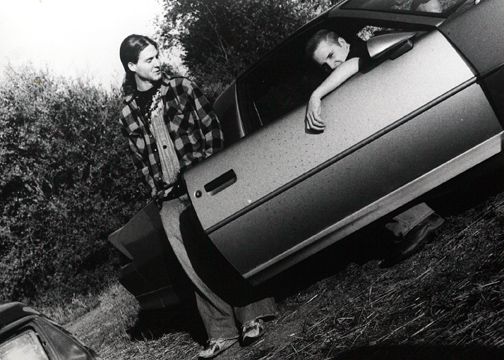In high school, one of the first photo assignments my teacher issued was to photograph “tilted horizons.” Naturally, all the students came back with landscapes demonstrating (ahem) a tilted horizon. There was nothing to it. Find a straight horizon line and just tilt the camera and presto, gimme an A! I think I did get an A. Reflecting back on this, I believe the lesson was meant to inspire us teenagers to think differently about how we look at the world and to be creative in how we capture it. However, there should have been a memo given to us in tandem with our graded portfolio: tilted horizons don’t equal a good photograph. Okay, maybe I was the only one who needed that, because after the initial assignment, I essentially tilted every horizon I encountered, no matter what was in it.
Clusters of people, parked automobiles, shrubs and trees, houses, barns, mountains—they all got the tilt. The 45 degree angle was an essential ingredient in my recipe for a delicious looking photo. But you can’t substitute fat with sugar, so stop trying!
I now attribute this angular obsession with inexperience. I was still developing my creative eye, and someone just taught me a quick trick to instantly transform mundane into magic. (Also see Holga, fish-eye lens, any Photoshop filter, and scheimpflug—I personally used that one gratuitously.) Instead of seeking out or generating photo-worthy content, I applied the tilt technique to compensate for the absence of attention-grabbing imagery. It was a shortcut to an A, which my laid-back, high school professor was more than happy to let me take. Anything for him to get back to his coffee and newspaper, anything for me to continue gossiping with the girls.

When presented with a new challenge, most people immediately search for the tips and tricks that will make the learning curve less steep—the straightaway to goal attainment. Otherwise, it takes awhile to develop a skill set—or lose weight, or play the guitar—and that’s no fun. Thus: Atkins diet and everyone and his brother knows how to play “Wish You Were Here” at a party. I want to be awesome right away! Unfortunately in these situations, you never develop an appreciation for what it really takes to triumph and so you revert: bacon for breakfast, lunch, and dinner. Forget the guitar, hands are too greasy anyway.
When I first strapped a snowboard to my feet and tried to maneuver down a hump in a hillside, my thrashing and flopping was so absurdly embarrassing that I almost resigned myself to becoming a permanent snow bunny in the lodge. You know, just dress the part but sip pink Chablis by the fire until the boys come back? Knowing I would hate myself, I decided to instead search for that one quick fix that would make all my clumsiness disappear. My stance was incorrect. I needed different boots. I should wax my board. And so on.
Because I’m a Drobny and pain and suffering are my number one and two motivators in life, respectively, I didn’t give up so easily on either snowboarding or photography when I couldn’t find the “silver bullet” to make me awesome. Eventually when I got to college, and later in grad school, expectations were way higher for creating solid imagery. Relying on gimmicks was not going to get me an A.
To snowboard proper, it took me three Vermont winters of bruised bottoms and damaged pride with absolutely no quick fix, no magic tricks, no shortcuts. To photograph with a vision, it took me eight years, two Georgia summers, and being emotionally stoned by my peers during critique. Fellow art students are unforgiving and relentless and are more than happy to publicly diarrhea on your self-esteem if you attempt to side-step your craft. With that being said, they also can be quite nice when you legitimately wow them.
I did rightly earn success. There was a formula, but it would require more than a simple magic ingredient and it was going to burn all the way down and taste like 151, minus the buzz. It went like this: Fuck up, own it, fix it, repeat. It’s quite the iterative process. Sometimes I repeated this 10, 12 times before I was victorious. For me, this is a difficult method to put myself through. I am that person who wants to be instantly awesome. I don’t like to fail and failing miserably and publicly is so painful for my brain that it causes me to do things like sob uncontrollably or drink heavily.
I have reached the conclusion, though, that this is the best way to learn. I had to understand the difference between doing it wrong and doing it right, and no one was in a more advantageous position to teach that to me except for myself. Over time and with practice, I improved and I could acutely point to the failed pieces and understand why they were so, because I bore them. And more importantly, I knew how to fix them because my mistakes were already made, right there for everyone to see and me to cry about.
To photograph a non-tilted horizon that people want to look at is actually a lot of work. (I admit that the photos above aren’t anything people should want to look at, despite the tilt. When I was 17, I thought they were AWESOME, though.) I know because I studied under some exceptional professors at SCAD who tirelessly spent hours capturing a perfectly exposed and color corrected landscape that would be terribly boring if it weren’t for the craft and skill expertly demonstrated to precisely represent the humdrumery happening in front of the lens. And, they expected me to do the same. I wasn’t going to get an “A” by merely tilting my 4×5. At that point, though, I wasn’t even interested in attempting an old trick. It was far more rewarding to create…and fail on my own terms than to apply a known recipe for success.


